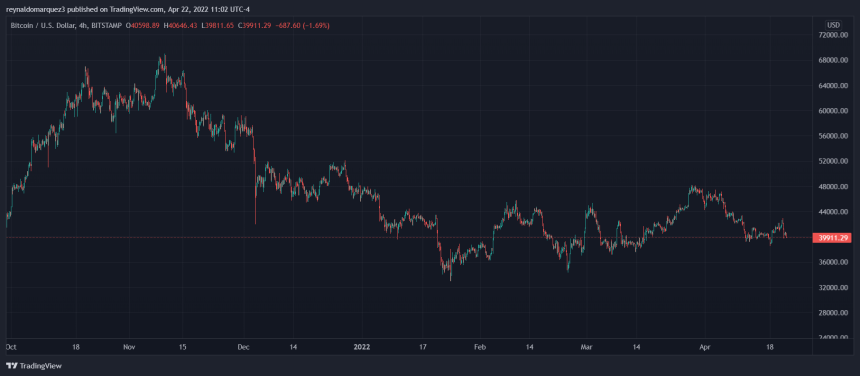Bitcoin remains rangebound in the high $30,000 to low $40,000 areas. The first crypto by market cap has seen its volatility reduce as several factors contribute to the slowdown across the sector.
Related Reading | TA: Bitcoin Trims Gains, Support Turned Resistance At $41K
At the time of writing, Bitcoin (BTC) trades at $40,500 with a 6% loss in the last 24-hours and a 1% profit over the past week.

Trading firm QCP Capital believes Bitcoin has been trading in a larger range as it reclaimed the area around its current levels. The firm claims that there are 2 main reasons behind BTC’s recent price action.
In addition to the U.S. Federal Reserve (FED) hinting at an aggressive monetary policy, there are expectations of Bitcoin and Ethereum revisiting critical support at $30,000 and $2,500, respectively. These expectations were generated by former BitMEX CEO Arthur Hayes’s latest post, “The Q Trap”.
In the options markets, traders are preparing for a potential drop as QCP Capital records a “massive selling of May and June calls, causing BTC and ETH risk reversal”. These levels dropped from negative 6% to negative 10%.
Conversely, the demand for BTC and ETH puts has increased. In other words, traders seem to be hedging for the upcoming crash by buying put (sell) options. If the price crashes, they will be able to benefit.
Ethereum has seen the biggest uptick in demand for put calls. QCP Capital attributed it to the delay of “The Merge”. The event is set to combine Ethereum’s execution layer with its consensus layer and make ETH 2.0 fully operational.
Bitcoin Finds Bottom With Stablecoin Craze
Bitcoin’s recent price action characterized by low volatility could also be the result of the popularization of algorithmic stablecoins, QCP Capital believes. These digital assets have been in the crypto space for many years, but Terra’s UST managed to give them new life.
The demand for UST has increased as users want to leverage the 19% annual percentage yield (APY) offered by Anchor Protocol. Other projects have begun imitating this model creating what the trading firm called a “soft floor in the market”. QCP Capital added:
We mentioned in a previous post that the precedent set by Luna Foundation Guard (LFG) would spread and that has happened quickly with a wave of announcements from FRAX, NEAR and TRON (…). Similar to how LFG bought BTC and AVAX, these algo stables will build their treasuries in the major coins and provide material support in the market from their buying.
The short-term relief in the market could be translated into long-term pressure. The trading firm claims that these digital assets could become a systematic risk for the sector.
If the entities managing these stablecoins buy BTC or ETH to maintain the pegged of their assets, there is a chance that a de-pegged scenario could increase the selling pressure in the market. If the stablecoins are at risk of becoming volatile, the entities will sell their assets to try to keep the pegged.
In any case, QCP Capital and others wonder about the long-term sustainability of the algorithmic stablecoins. UST, Terra’s native stablecoins, has been battle-tested, but many wonder if it will be able to keep its users with the rising competition.
Related Reading | Why A “Boring” Bitcoin Could Be A Good Thing
In the meantime, as expectations of a May/June crash increase and algo stablecoins proliferate, Bitcoin seems poised to remain rangebound with short-term price action to the downside. According to Material Indicators, BTC’s price will seek to take the liquidity of around $37,000.
#FireCharts is showing ~$100M in #bitcoin bid liquidity between here and $37.5k range. Expecting it to get filled, but watching to see if #BTCUSDT liquidity moves to the active buy zone or the buy zone moves to the orders resting on the @binance order book.https://t.co/26BLOFwenL pic.twitter.com/NdAGc48yfY
— Material Indicators (@MI_Algos) April 22, 2022
